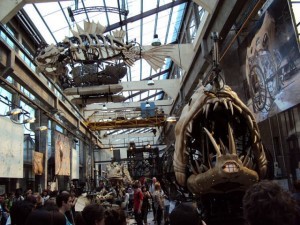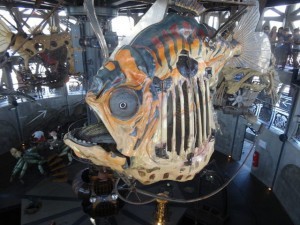Born from the imaginations of two French artists, Francois Delarozière and Pierre Orefice, and inspired by the industrial history of Nantes, as well as from the creations and worlds of Jules Verne and Leonardo Da Vinci, the Machines of the Isle of Nantes is an artistic project like no other.
Located in the city’s former shipyard, it is a whole park of steam-powered machinery, ranging from a giant elephant trough flying herons, a mechanical dragon, a carousel revolving with deep sea creatures to two-meter long centipede crawling on a rail track.
(An original theme park based in Nantes, on the banks of the Loire river in France)
(Located in the city’s former shipyard)
(Since 2002, Delarozière and Orefice have devoted their time and energy to this project)
(A Pirate Fish)
(Another mechanical deep sea creature)
The most famous of the creations is the 39ft high Great Elephant.
This giant creation was made from 45 tons of wood and steel, and it can take up to 50 people on its back for a 45-minute walk around the isle, trumpeting and spraying water from its trunk as it goes.
(The Grand Elephant, a massive articulated robot)
(It can take up to 50 passengers for a 45-minute walk)
(The Heron Tree)
(The Marine Worlds Carousel)
(Most of the machines have seats inside. They also have controls which allow them to be manipulated)
Since its creation, the machine has become the unofficial symbol of Nantes, appearing even on souvenirs and postcards.
Another giant mechanical attraction is the “The Heron Tree“ or “Arbre aux Herons,“ a massive 164ft wide and 98ft tall, steel structure topped with two herons.
(A mechanical dragon)
Further to the west, rising nearly 25m high and measuring 20m in diameter, is The Marine Worlds Carrousel – a huge carousel that features 24 mechanical waves and 35 rotating underwater creatures on three levels: the ocean floor, the depths, and the sea and boats.
There is also a workshop, a place where the machines are made and a Machines Gallery which illustrates the background story of the robotic giants, from the very first sketches to the fully functioning machines.
Ask me anything
Explore related questions

















